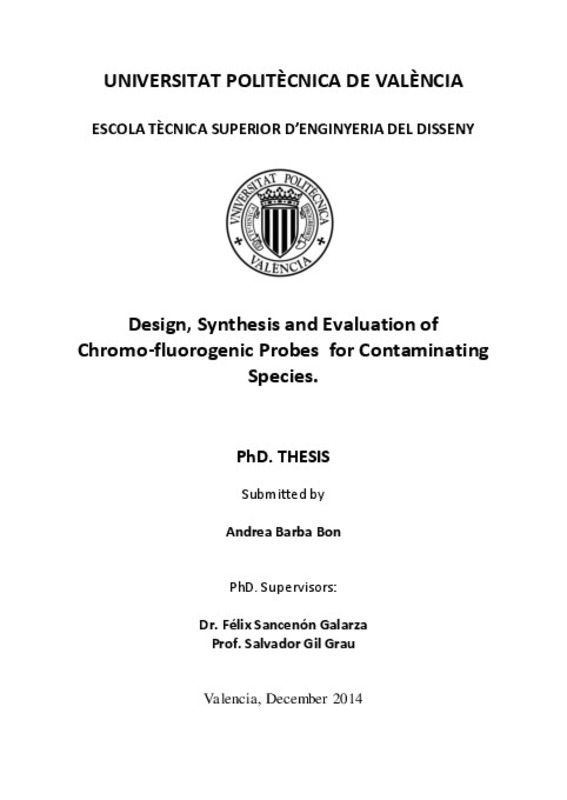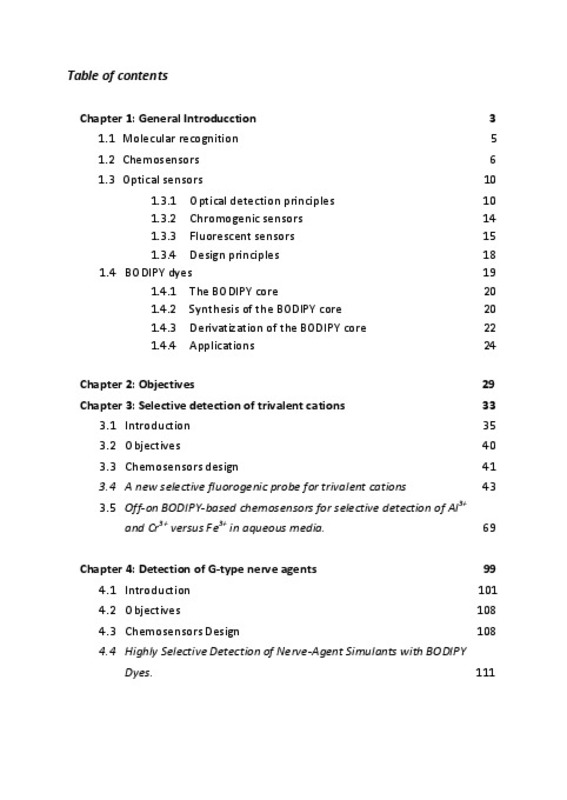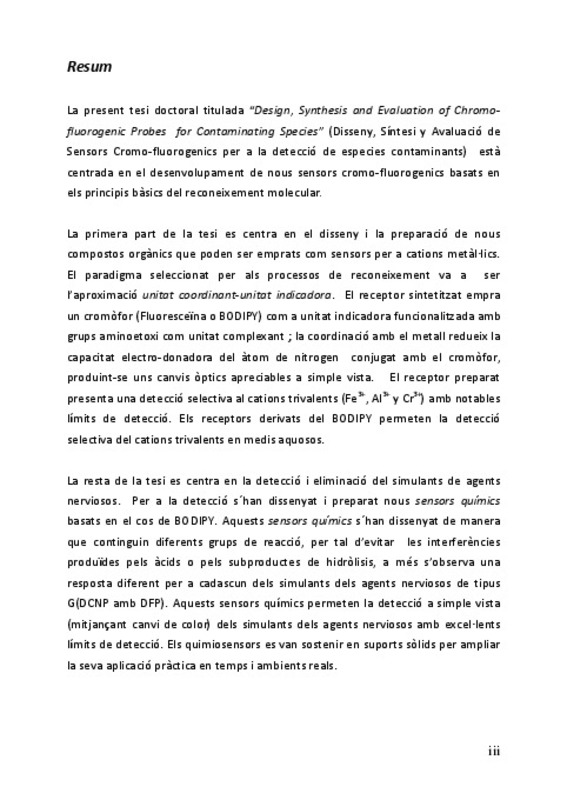- RiuNet repositorio UPV
- :
- Investigación
- :
- Tesis doctorales
- :
- Ver ítem
JavaScript is disabled for your browser. Some features of this site may not work without it.
Buscar en RiuNet
Listar
Mi cuenta
Estadísticas
Ayuda RiuNet
Admin. UPV
Design, Synthesis and Evaluation of Chromo-fluorogenic Probes for Contaminating Species
Mostrar el registro sencillo del ítem
Ficheros en el ítem
| dc.contributor.advisor | Gil Grau, Salvador
|
es_ES |
| dc.contributor.advisor | Sancenón Galarza, Félix
|
es_ES |
| dc.contributor.author | Barba Bon, Andrea
|
es_ES |
| dc.date.accessioned | 2015-03-31T06:01:42Z | |
| dc.date.available | 2015-03-31T06:01:42Z | |
| dc.date.created | 2014-12-22 | es_ES |
| dc.date.issued | 2015-03-31 | es_ES |
| dc.identifier.uri | http://hdl.handle.net/10251/48521 | |
| dc.description.abstract | The present PhD thesis entitled “Design, Synthesis and Evaluation of Chromofluorogenic Probes for Contaminating Species” is focused on the development of new chromo-fluorogenic sensors based on the principles of molecular recognition. The first part of this thesis is focused on the design and synthesis of suitable organic compounds as sensors for metal cations. The selected sensing paradigm was the binding site-signalling subunit approach. The synthetized receptors employs a chromophore (fluorescein or BODIPY) skeleton as signalling subunit and it is functionalized with aminoethoxy moieties as binging site; the metal coordination reduces the electron-donating ability of the nitrogen atom conjugated to the chromophore resulting in optical changes noticeable to the naked-eye. The sensing behavior is highly selective to trivalent cations (Fe3+, Al3+ and Cr3+) with remarkable limits of detection. The receptors based on BODIPYdyes retain the sensing abilities in mixed aqueous solutions. The remaining chapters of the thesis are centered in the detection and removal of nerve agents surrogates. The design, synthesis, characterization and application of new BODIPY chemosensors were studied. These chemosensors were designed containing different reactive sites in order to avoid interferences produced by acids or hydrolysis products, and also be able to distinguish between the different G-nerve agent mimics (DCNP and DFP). The BODIPY-probes allows screening of nerve agent surrogates with remarkable limits of detection and optical changes noticeable to the naked-eye. The sensing abilities are retained in solid support, allowing practical application in real-time monitoring by simple colorimetric tests. The displacement assay approach has been used to develop a selective sensor for V-nerve agent surrogates versus G-type. For this purpose, two Eu3+ and Au3+ BODIPY-complexes were prepared. In this case, V-surrogate is capable of coordinate the metallic center, releasing the BODIPY ligand. This causes a change in the optical properties visible to the naked-eye. Finally, the use of supramolecular-based organocatalyst for destruction of OP nerve agent surrogates was studied. Hydrolysis studies were performed in presence of 1,3-diindolylureas and thioureas, amines, aminoalcohol and glycols. Addition of catalyst enhances the electrophilic character of the P atom, and the final nucleophilic attack of water that results in the formation of the corresponding less toxic organophosphate derivatives, thus higher hydrolysis rates are obtained. | en_EN |
| dc.language | Inglés | es_ES |
| dc.publisher | Universitat Politècnica de València | es_ES |
| dc.rights | Reserva de todos los derechos | es_ES |
| dc.subject | Chemosensor | es_ES |
| dc.subject | Fluoresent probes | es_ES |
| dc.subject | Triple-chargued cations | es_ES |
| dc.subject | BODOPY-dyes | es_ES |
| dc.subject | Neurological agents | es_ES |
| dc.subject | Complexation | es_ES |
| dc.subject | Hydrolysis | es_ES |
| dc.subject | Catalyst. | es_ES |
| dc.subject.classification | QUIMICA INORGANICA | es_ES |
| dc.subject.classification | QUIMICA ORGANICA | es_ES |
| dc.title | Design, Synthesis and Evaluation of Chromo-fluorogenic Probes for Contaminating Species | es_ES |
| dc.type | Tesis doctoral | es_ES |
| dc.identifier.doi | 10.4995/Thesis/10251/48521 | es_ES |
| dc.rights.accessRights | Abierto | es_ES |
| dc.contributor.affiliation | Universitat Politècnica de València. Escuela Técnica Superior de Ingeniería del Diseño - Escola Tècnica Superior d'Enginyeria del Disseny | es_ES |
| dc.description.bibliographicCitation | Barba Bon, A. (2014). Design, Synthesis and Evaluation of Chromo-fluorogenic Probes for Contaminating Species [Tesis doctoral]. Universitat Politècnica de València. https://doi.org/10.4995/Thesis/10251/48521 | es_ES |
| dc.description.accrualMethod | TESIS | es_ES |
| dc.type.version | info:eu-repo/semantics/acceptedVersion | es_ES |
| dc.relation.pasarela | TESIS\8151 | es_ES |
Este ítem aparece en la(s) siguiente(s) colección(ones)
-
Tesis doctorales [5389]












